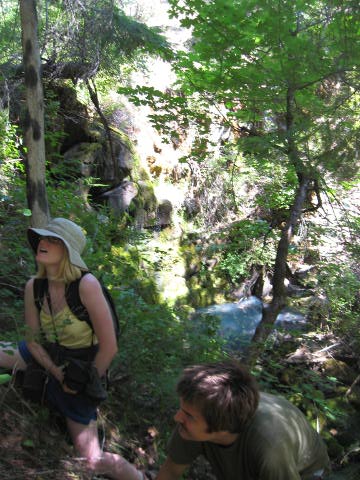Exploring the Klickitat
Lindsay:
We are lucky to live here on the plateau, where we can walk out our door and keep walking, through lands little touched by humans. These are not "wild" lands in any strict sense, as the mark of the human hand is quite visible to those who look for it, but these are lands where the processes necessary for a healthy, self-managing ecosystem remain functional. And it is through observing these processes, day after day, season after season, that we learn how it is we are to live well, within the bounds of the ecosystem that supports us.
Andrew and Oana hike the crest of our plateau
 |
| |
There are few universal answers for how to live rightly on this earth, but to the degree that this question drives the search for sustainability, for sustenance that keeps nourishing, wholly and thoroughly, the answer for us lies not just in the land that we greet daily with our feet, but all the lands that feed the Klickitat that flows 1,500 feet below. So, the challenge remains to close this gap between the land that my body knows and the rest of the land that falls within the watershed of the Klickitat River.
taking time out for a nap
 |
| |
This is a task that could very well take decades, perhaps a life-time is more necessary and in that time it still may not be considered complete. However, I am drawn to such long-term endeavors, endeavors that continually teach, and with each year the learning grows deeper.
Sam passes by a lightning struck Doublas Fir
 |
| |
There may be many ways to set out on such a task--to get to know an entire watershed‒and it is indeed an overwhelming project when viewed in its entirety. But over the past few months, as the days have been long and the nights warm, we have been more deliberately exploring the many places still unknown to us, though they exist just a few miles away. We have been setting out, sometimes on trails, but more often not, along canyon edges and down stream beds, to the point when our feet our tired and water bottles empty.
Jon, Celeste and Oana follow a trail up the ridge
 |
| |
One reliable feature of landscapes is that water flows downhill‒a convenient characteristic when exploring unfamiliar places and nothing more than a general sense of where you want to go as your guide.
Swale Canyon Creek
 |
| |
So, we have been using seasonal stream beds to guide us through various portions of the plateau down to the Klickitat. And what we find is always worth our while‒hidden lagoons and mid-summer waterfalls, moss-laden oaks that create inviting resting spots and petrified redwoods that invoke a sense of deep time, views that humble and waters that refresh.
pausing for a group photo
 |
| |
On such walk-abouts, its hard not to think of what lands were like before large-scale and intense human modification. How does knowing a landscape, its flora and fauna, its relationships and processes‒in the way that most people today know only city streets, product brands and technological gadgets‒impact the psyche, the soul, the intellect, our sense of identity and place in this world? And for such knowledge to be motivated by survival, of life and culture, and to allow from there the rise of philosophical meaning and spiritual practices.
Sarah and Jon in Wahkiacum canyon
 |
| |
This is not so much a new idea, as many nature writers over the centuries have covered the topic fairly thoroughly, but reading the words of others, no matter how poetic or precise, does little justice to knowing this feeling in your body, and this knowledge in your bones.
Charlie-dog running the ridge
 |
| |
Notes From Windward - Index - Vol. 70
|
|







